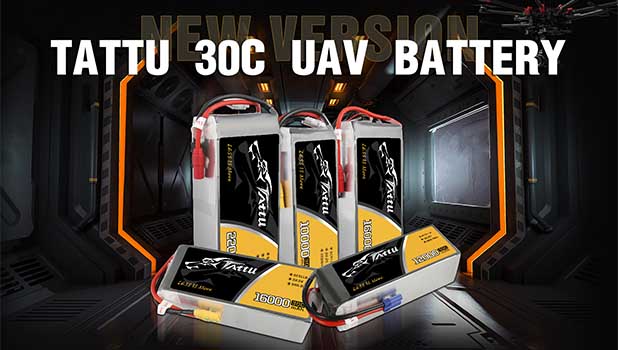Article cited: Tattu 6S 30C Drone Battery
Tattu brand 30C drone battery series is new products of Grepow, has stable automatic stacking technology, high capacity than comparable size pack and no memory effect. And it is a nice compact little battery, with excellent build and assembly quality. 30C 6S UAV drone battery series designed for multicopter, low IR value of these batteries also provides stable voltage until the end of your mission.
Tattu 30C 6S drone battery series features: slower voltage drop, more robust power, higher performance and longer flight time.

Tattu 6S 30C UAV Drone Battery Lists:
| Tattu 6S 30C UAV batteries list | |
| Properties | Parameters |
| Chemistry | LiPo Battery (Lithium Polymer Battery) |
| Capacity(mAh) | 10000, 12000, 16000, 22000 |
| Configuration | 6S / 22.2V / 6 cells |
| Discharge Rate | 30C |
| Max Burst Discharge Rate | 60C |
| Net Weight(±20g) | 10000mAh: 1357g
12000mAh: 1532g
16000mAh: 1974g
22000mAh: 2460g
|
| Dimensions (L x W x H) | 10000mAh: 175mm x 65mm x 58mm
12000mAh: 190mm x 71mm x 54mm
16000mAh: 190mm x 76mm x 65mm
22000mAh: 206mm x 91mm x 61mm
|
Tattu 6S 30C Drone Battery Video:
About Tattu Brand
Grepow self-owned brands “格氏ACE”, “GENS ACE” and “TATTU” are renowned home and abroad. For Tattu Brand, it is more focused on Drones / Multirotors / UAV battery pack and designed with high energy density and high discharge rate cells. It has highly reputation in the market with its stable performance. We are committed to supply the safe, stable as well as long cycle life battery for UAV.
You may also like:
Learn more UAV Drone Batteries’ informantion? please check HERE
Not Find You Need? Try Our Customized Service; Professional Customized of Drone Batteries and Battery Solutions.
Any questions please let us know: info@grepow.com
